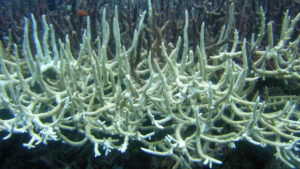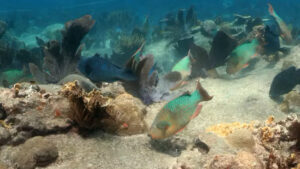By Lorenzo Alvarez-Filip and Ana Lilia Molina Hernández, National Autonomous University of Mexico (Universidad Nacional Autónoma de México/UNAM)
After two years of record-breaking ocean heat, scientists are assessing the impacts of the world’s fourth mass bleaching event on coral reefs around the globe. At least 74 countries and territories are confirmed to have experienced coral bleaching since the spring of 2023.
As coastal development, pollution and climate change put increasing stress on the world’s oceans, tropical reefs are losing reef-building corals at unprecedented rates. These corals – species with rigid skeletons, such as elkhorn and brain corals – are the architects of these ecosystems, providing the foundations for coral reef communities.

Coral reefs perform many important functions, such as buffering coastlines and providing habitat for one-fourth of all marine species. In the U.S. alone, these ecological services are worth an estimated $3.4 billion yearly.
Over the past several decades, many studies have spotlighted the role of “grazers” – fish who feed on algae – in keeping coral reefs clean and healthy. Protecting parrotfish, a family of some 90 species of large, colorful grazers, has become a tenet of reef conservation policies.
We have analyzed indicators of reef health and resilience and assessed the roles parrotfish play in controlling seaweed, promoting coral growth and eroding reefs. While it is clear that parrotfish are an important part of coral reef communities, management strategies focusing on them, in our view, have not fully proved effective. In a review of recent science, we showed why conservation programs need to rethink the role parrotfish can play as a conservation tool to improve reef health.
The parrotfish paradigm
Corals and the reef bottom they live on need to stay clean to prevent seaweed from growing on their surfaces. Excessive seaweed growth on reefs can block sunlight from corals’ surfaces, release chemicals that affect coral survival, slow the corals’ growth and make it harder for new corals to establish themselves and build reef structures.

When disease or bleaching kills corals on a reef, other fast-growing organisms, including seaweed, rapidly colonize the dead corals’ skeletons. This impedes new corals from settling and surviving on the reef, and locks the ecosystem into a state of low growth and poor recovery.
In this context, it is easy to see why protecting algae-eating fish has become a cornerstone of coral reef conservation. This paradigm assumes that restoring populations of “grazing” species by protecting them from fishing is essential for controlling seaweeds, improving reef health and promoting coral recovery.
This strategy has spurred governments in many countries, including Belize, Bermuda, Guatemala, Honduras, Mexico, Colombia and the U.S., to create marine protected areas, restrict fishing in designated zones and ban parrotfish harvesting.
Missing pieces of parrotfish protection
Evidence shows that conservation measures have increased parrotfish populations in some places, such as Bonaire and Belize, with positive effects on reefs. However, parrotfish increases have not always reduced algae growth or increased coral cover. In our review, we highlight three main factors that may be hindering the success of this approach in the Caribbean.
First, parrotfish management has traditionally treated all species as if they consume the same amount of algae. This notion leads to using measures like the total number or total weight of parrotfish present in a given reef as proxies for seaweed consumption.

However, not all parrotfish are the same. Some species, such as the redband parrotfish, effectively remove algae, while others, such as the blue parrotfish, barely eat it. More precise and targeted conservation measures would consider each species’ specific impact on seaweed growth.
Second, while parrotfish help reefs to grow by keeping them clean, they also can cause gradual erosion of reef structures. Some parrotfish species graze by biting off chunks of coral, especially from dead skeletons, and grinding it in their digestive systems, excreting it as sand.
This bioerosion process is natural and essential. But on highly degraded reefs with low coral cover, large numbers of eroding parrotfish can accelerate reef breakdown.
Increases or declines in populations of parrotfish influence the intensity of erosion. But focusing so closely on parrotfish has unintentionally overlooked the erosive capacity of these fishes by assuming all parrotfish have the same effect on the ecosystem. This raises an important question: Which species are favored by restrictions on harvesting parrotfish?
Our research shows that key bioeroding species that break down dead coral, such as the queen parrotfish and the stoplight parrotfish, are more vulnerable to overfishing because they are larger and take longer to mature. This means that reducing or restricting their catch might unintentionally increase bioerosion. For these ecosystems, increasing parrotfish numbers might not reduce algae growth enough to fully offset higher rates of bioerosion.
Conservation strategies that evolve
As science progresses and new evidence emerges, it is crucial to reexamine conservation strategies and see whether they need to be updated or even scrapped. This ongoing process of refining plans based on evolving knowledge is known as adaptive management and is widely used in ecology and conservation.
We are not calling for an end to protecting parrotfish. However, no single strategy can be a comprehensive tool for conserving coral reefs, which are very complex ecosystems.
Rather, we want to encourage people – especially reef managers and scientists – to recognize the different roles that various parrotfish species play and the varying challenges each species faces, and tailor reef protection efforts accordingly. We also believe it is critical to do more to counter the causes of coral mortality, including climate change, coastal development and water pollution. Along with grazers to keep them clean, coral reefs need cleaner waters and cooler oceans to ensure their long-term survival.![]()
Lorenzo Alvarez-Filip is a professor of marine ecology and Ana Lilia Molina Hernández is a postdoctoral research fellow at the National Autonomous University of Mexico (Universidad Nacional Autónoma de México/UNAM).
This article is republished from The Conversation under a Creative Commons license. Read the original article. Banner photo: A stoplight parrotfish in the Bahamas (James St. John, CC BY 2.0, via Wikimedia Commons).
Sign up for The Invading Sea newsletter by visiting here. To support The Invading Sea, click here to make a donation. If you are interested in submitting an opinion piece to The Invading Sea, email Editor Nathan Crabbe at ncrabbe@fau.edu. To learn more about coral bleaching, watch the video below.



